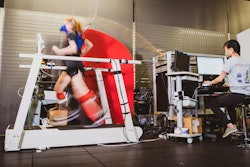Can Humans Keep Up With Machines?
Elon Musk is trying to conquer land with Tesla, space with SpaceX, and now he's after our brains.
On Tuesday, the Wall Street Journal reported that the tech billionaire is launching a new venture called Neuralink, which is focused on linking brains to computers. According to the report, the company will further brain implant technology that can one day be used to treat neural disorders.
We've seen similar tech in impressive applications, like the EEG-based brain-computer interface from the University of Minnesota, which allows people to control a robotic arm using only their minds; the brain-machine interface from the Walk Again Project, which allows the user to control the movements of a lower-limb robotic exoskeleton; and the DARPA-funded research out of the University of Pittsburgh which helped a quadriplegic man feel the sense of tough again by directly connecting a robotic arm to his brain.
According to the report, Neuralink already has hired several leading researchers in the field.
Neuralink's implants could also help the human race keep up with super-intelligent computers in the future.
Musk has been very outspoken about the risk that unchecked artificial intelligence poses to humans. In January 2015, he joined Stephen Hawking and other A.I. experts who signed an open letter on artificial intelligence from the Future of Life Institute which called for further research on the societal benefits of A.I., as well as potential pitfalls.
In a tweet, Musk said that we can expect more information on the new venture in about a week.
U-Lion UAV Reconfigures Mid-Flight
This is the U-Lion, a hybrid vertical take-off and landing (VTOL) UAV that takes off and lands like a helicopter, and transitions in mid-air to fly like a normal airplane.
The U-Lion was designed by a pair of PhD students with the National University of Singapore, Unmanned System Research Group who spent four years developing the hybrid UAV.
The U-Lion's wings retract and extend to stabilize the craft during take-off and landing, and provide lift during flight. The hybrid UAV would be particularly useful in both military and civilian operations whenever the user was working in a tight window, like sea surveillance or forest mapping.
The viability is the reason that several companies are working on vastly different concepts, like Google’s Project Wing automated aircraft hybrid UAV that recently started testing at an FAA test site run by Virginia Tech.
U-Lion is unique because of its reconfigurable wings and vectoring thrust that adopt to the flight mission, depending on the requirements. This allows it to fly much longer than typical VTOL UAVs and have greater maneuverability compared to normal fixed wing UAVs.
Army Wants to Give Soldiers a Third Arm
Army ground troops may soon have a "third arm" that will carry their weapon for them. Now, this isn't some sort of crude joke, but rather a device that attaches to a soldier's protective vest to free up his/her hands to hold a shield, or for example, use a power saw during a breach.
The Army Research Lab is currently testing the four-pound weapon mount as they look at new ways for soldiers to interface with their weapons.
According to Zac Wingard, a mechanical engineer at the lab, the hope it to be able to improve "ballistic performance of future weapons without increasing soldier burden." So, when soldiers start to carry handheld laser weapons and railguns, it will likely increase their combat loads that already exceed 110 pounds.
The third arm puts all of the weight on the soldier's body, taking about twenty pounds off of their arms, which could also help keep soldiers from breaking down in training, before they ever see a day in combat.
The third arm is made out of carbon fiber composite, and the research lab is currently testing it at the Aberdeen Proving Ground in Maryland with an M4 carbine, though the plan is test larger weapons, like the M240B machine gun.
Right now, researchers are just at the shooting range, and before they do any field testing, they’ll have to ruggedize the proof-of-concept.






















